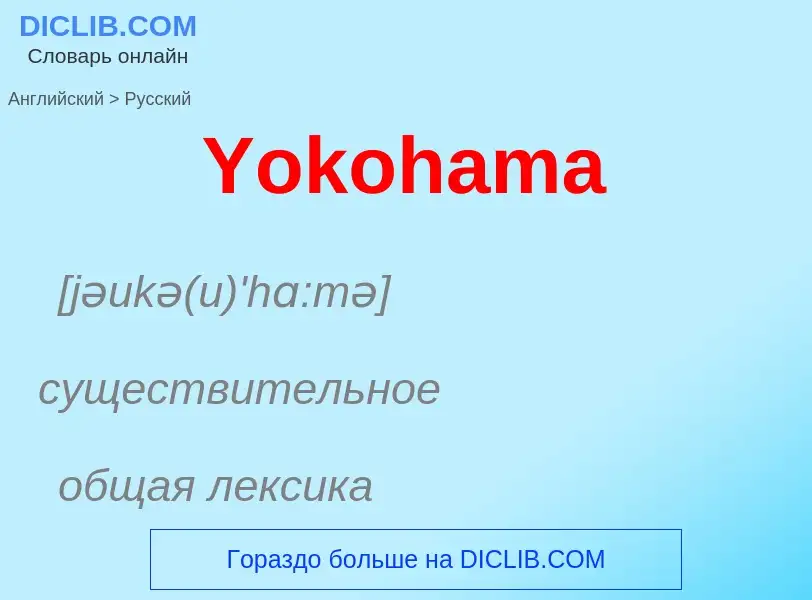Tradução e análise de palavras por inteligência artificial ChatGPT
Nesta página você pode obter uma análise detalhada de uma palavra ou frase, produzida usando a melhor tecnologia de inteligência artificial até o momento:
- como a palavra é usada
- frequência de uso
- é usado com mais frequência na fala oral ou escrita
- opções de tradução de palavras
- exemplos de uso (várias frases com tradução)
- etimologia
Yokohama - tradução para russo
[jəukə(u)'hɑ:mə]
существительное
общая лексика
г. Йокохама
география
г. Иокохама
Иокогама
Wikipédia

Yokohama (Japanese: 横浜, pronounced [jokohama] (listen)) is the second-largest city in Japan by population and the most populous municipality of Japan. It is the capital city and the most populous city in Kanagawa Prefecture, with a 2020 population of 3.8 million. It lies on Tokyo Bay, south of Tokyo, in the Kantō region of the main island of Honshu. Yokohama is also the major economic, cultural, and commercial hub of the Greater Tokyo Area along the Keihin Industrial Zone.
Yokohama was one of the cities to open for trade with the West following the 1859 end of the policy of seclusion and has since been known as a cosmopolitan port city, after Kobe opened in 1853. Yokohama is the home of many Japan's firsts in the Meiji period, including the first foreign trading port and Chinatown (1859), European-style sport venues (1860s), English-language newspaper (1861), confectionery and beer manufacturing (1865), daily newspaper (1870), gas-powered street lamps (1870s), railway station (1872), and power plant (1882). Yokohama developed rapidly as Japan's prominent port city following the end of Japan's relative isolation in the mid-19th century and is today one of its major ports along with Kobe, Osaka, Nagoya, Fukuoka, Tokyo and Chiba.
Yokohama is the largest port city and high tech industrial hub in the Greater Tokyo Area and the Kantō region. The city proper is headquarters to companies such as Isuzu, Nissan, JVCKenwood, Keikyu, Koei Tecmo, Sotetsu, Salesforce Japan and Bank of Yokohama. Famous landmarks in Yokohama include Minato Mirai 21, Nippon Maru Memorial Park, Yokohama Chinatown, Motomachi Shopping Street, Yokohama Marine Tower, Yamashita Park, and Ōsanbashi Pier.


![Kanagawa Prefectural Office]] Kanagawa Prefectural Office]]](https://commons.wikimedia.org/wiki/Special:FilePath/Kanagawa Prefectural Office.jpg?width=200)





![JR East]]) JR East]])](https://commons.wikimedia.org/wiki/Special:FilePath/YokosukaLineStations.png?width=200)
![Perry]] and men to meet the Imperial commissioners at Yokohama, 14 July 1853 Perry]] and men to meet the Imperial commissioners at Yokohama, 14 July 1853](https://commons.wikimedia.org/wiki/Special:FilePath/Commodore-Perry-Visit-Kanagawa-1854.jpg?width=200)




![[[Yokohama Red Brick Warehouse]] was built in 1913. [[Yokohama Red Brick Warehouse]] was built in 1913.](https://commons.wikimedia.org/wiki/Special:FilePath/Akarenga_Yokohama_2012.jpg?width=200)
![Crown Prince [[Hirohito]] (later Emperor) visited Yokohama immediately after the [[1923 Great Kantō earthquake]]. Crown Prince [[Hirohito]] (later Emperor) visited Yokohama immediately after the [[1923 Great Kantō earthquake]].](https://commons.wikimedia.org/wiki/Special:FilePath/HIH the Prince Regent viewing devastated Yokohama-restored.jpg?width=200)

![USS ''General George M. Randall'' (AP-115)]], departs Yokohama, repatriating war dead to the U.S. USS ''General George M. Randall'' (AP-115)]], departs Yokohama, repatriating war dead to the U.S.](https://commons.wikimedia.org/wiki/Special:FilePath/Yokohama Koreanwar.jpg?width=200)


![View from the [[Yokohama Bay Bridge]] (2007) View from the [[Yokohama Bay Bridge]] (2007)](https://commons.wikimedia.org/wiki/Special:FilePath/Minato mirai view from Yokohama bay bridge (2039218244).jpg?width=200)
![View from [[Hikawa Maru]] (2014) View from [[Hikawa Maru]] (2014)](https://commons.wikimedia.org/wiki/Special:FilePath/View from Hikawa maru, Yokohama (15988315167).jpg?width=200)
![Sankei-en Garden]] Sankei-en Garden]]](https://commons.wikimedia.org/wiki/Special:FilePath/Sangkaien Garden.jpg?width=200)
![Isezaki San Francisco Lane]] Isezaki San Francisco Lane]]](https://commons.wikimedia.org/wiki/Special:FilePath/伊勢佐木町2012年8月24日(金).jpg?width=200)
![Motomachi]] Motomachi]]](https://commons.wikimedia.org/wiki/Special:FilePath/Saint Patricks Day in Motomachi Yokohama.jpg?width=200)
![[[Yokohama Chinatown]] [[Yokohama Chinatown]]](https://commons.wikimedia.org/wiki/Special:FilePath/Chinatown in Yokohama 10.jpg?width=200)
![Harbor View Park towards the [[Yokohama Bay Bridge]] Harbor View Park towards the [[Yokohama Bay Bridge]]](https://commons.wikimedia.org/wiki/Special:FilePath/Harbour View Park, Yamate, Yokohama.jpg?width=200)
![[[Kanagawa Prefectural Museum of Cultural History]] [[Kanagawa Prefectural Museum of Cultural History]]](https://commons.wikimedia.org/wiki/Special:FilePath/Kanagawa Prefectural Museum of Cultural History 2009.jpg?width=200)
![CupNoodles Museum]] CupNoodles Museum]]](https://commons.wikimedia.org/wiki/Special:FilePath/Cupnoodles Museum Yokohama 2017.jpg?width=200)
![[[Hikawa Maru]] [[Hikawa Maru]]](https://commons.wikimedia.org/wiki/Special:FilePath/Left-side view of Hikawa-maru.jpg?width=200)
![[[Yokohama Marine Tower]] [[Yokohama Marine Tower]]](https://commons.wikimedia.org/wiki/Special:FilePath/横浜マリンタワー2.jpg?width=200)


![[[Yokohama Hakkeijima Sea Paradise]] [[Yokohama Hakkeijima Sea Paradise]]](https://commons.wikimedia.org/wiki/Special:FilePath/Yokohama Hakkeijima Sea Paradise.jpg?width=200)
![[[Yokohama Cosmo World]] [[Yokohama Cosmo World]]](https://commons.wikimedia.org/wiki/Special:FilePath/Cosmo Clock 21 at night.jpg?width=200)
![[[Yokohama Station]] [[Yokohama Station]]](https://commons.wikimedia.org/wiki/Special:FilePath/Yokohama-west-station-building-202009.jpg?width=200)
![[[Yokohama Museum of Art]] [[Yokohama Museum of Art]]](https://commons.wikimedia.org/wiki/Special:FilePath/Yokohama Museum of Art 2009.jpg?width=200)
![[[Yokohama Archives of History]] [[Yokohama Archives of History]]](https://commons.wikimedia.org/wiki/Special:FilePath/Yokohama Archives of History02.jpg?width=200)
![Negishi Park]] Negishi Park]]](https://commons.wikimedia.org/wiki/Special:FilePath/Negishi Horse Racing Track.jpg?width=200)

![[[Sōji-ji]] [[Sōji-ji]]](https://commons.wikimedia.org/wiki/Special:FilePath/Sōjiji Daisodo 2009.jpg?width=200)
![[[Yokohama Stadium]] exterior [[Yokohama Stadium]] exterior](https://commons.wikimedia.org/wiki/Special:FilePath/Yokohama stadium 2020 wing.jpg?width=200)
![[[Yokohama Stadium]] crowd [[Yokohama Stadium]] crowd](https://commons.wikimedia.org/wiki/Special:FilePath/Yokohama Stadium, Baseball Stadium.jpg?width=200)
![[[Yokohama Arena]] exterior [[Yokohama Arena]] exterior](https://commons.wikimedia.org/wiki/Special:FilePath/Yokohama Arena 2013.jpg?width=200)
![Nissan Stadium]] exterior Nissan Stadium]] exterior](https://commons.wikimedia.org/wiki/Special:FilePath/Nissan International Stadium Yokohama.jpg?width=200)
![Nissan Stadium]] crowd Nissan Stadium]] crowd](https://commons.wikimedia.org/wiki/Special:FilePath/International Stadium Yokohama-1.jpg?width=200)
![Nishi-ku]] Nishi-ku]]](https://commons.wikimedia.org/wiki/Special:FilePath/Nissan headquarters 2022.jpg?width=200)
![Kanagawa-ku]] Kanagawa-ku]]](https://commons.wikimedia.org/wiki/Special:FilePath/JVCKENWOOD001.jpg?width=200)
![Kōhoku-ku]] Kōhoku-ku]]](https://commons.wikimedia.org/wiki/Special:FilePath/Koei Tecmo headquarters -01.jpg?width=200)
![Keikyu Group]] headquarters in Nishi-ku Keikyu Group]] headquarters in Nishi-ku](https://commons.wikimedia.org/wiki/Special:FilePath/Keikyu Group Headquarters.jpg?width=200)
![Sotetsu]] headquarters in Nishi-ku Sotetsu]] headquarters in Nishi-ku](https://commons.wikimedia.org/wiki/Special:FilePath/Sotetsu HQ Building.jpg?width=200)
![[[Isuzu]] headquarters in Nishi-ku [[Isuzu]] headquarters in Nishi-ku](https://commons.wikimedia.org/wiki/Special:FilePath/Yokohama Gate Tower - 04a.jpg?width=200)
